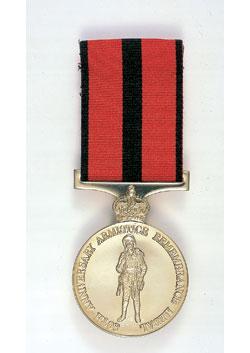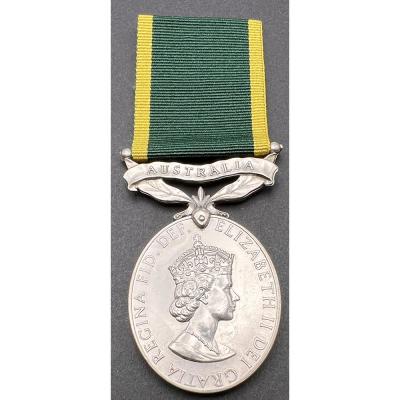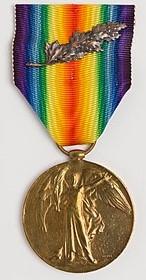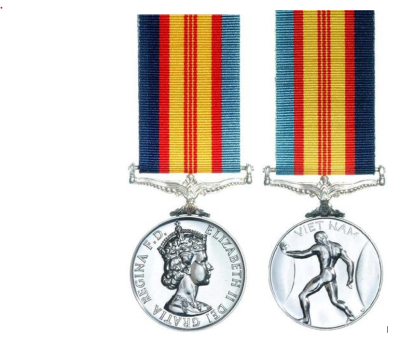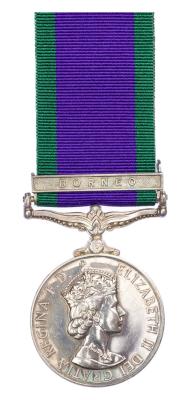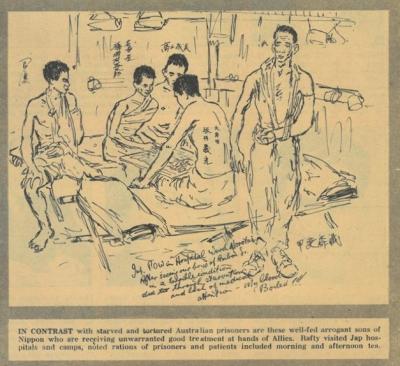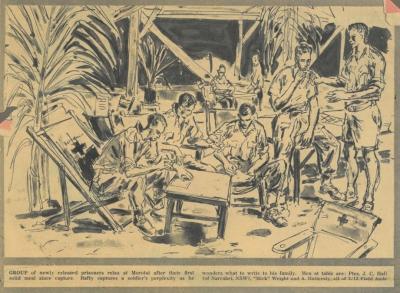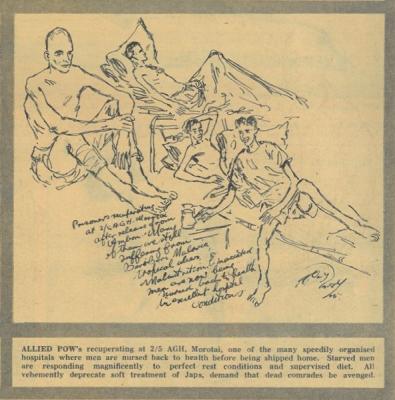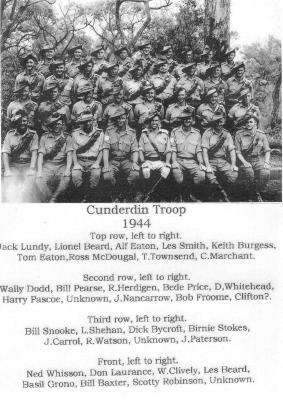Medal - British War Medal
The medal, struck by the Royal Mint, is a silver or bronze disk, 36 millimetres in diameter, with a straight clasp suspender without swivel. The obverse shows Sir Bertram Mackennal's bareheaded effigy of King George V facing left, with the legend "GEORGIVS V BRITT: OMN: REX ET IND: IMP:" (George V, King of all the British Isles and Emperor of India).
The reverse, designed by William McMillan, shows Saint George naked on horseback and armed with a short sword, an allegory of the physical and mental strength which achieved victory over militarism. The horse tramples on the Prussian eagle shield and the emblems of death, a skull and cross-bones. In the background are ocean waves and just off-centre near the right upper rim is the risen sun of Victory. The years "1914" and "1918" appear on the perimeter in the left and right fields respectively.
The watered silk ribbon is 32 millimetres wide, with a 3 millimetres wide royal blue band, a 2 millimetres wide black band and a 3 millimetres wide white band, repeated in reverse order and separated by a 16 millimetres wide orange band. The colours are not thought to have any particular symbolic significance.
The British War Medal is a campaign medal of the United Kingdom which was awarded to officers and men of British and Imperial forces. was instituted on 26 July 1919 for award to those who had rendered service between 5 August 1914, the day following the British declaration of war against the German Empire, and the armistice of 11 November 1918. About 6.5 million were struck in silver and 110,000 in bronze, the latter awarded to, among others, the Chinese, Maltese and Indian Labour Corps.
The British War Medal was awarded to all officers and men of British and Imperial forces who had served for a prescribed period during any stage of the war, or who had died on active service before the completion of this period. Eligibility was subsequently extended to cover service in 1919 and 1920 in mine-clearing at sea as well as participation in operations in North and South Russia, the eastern Baltic region, Siberia, the Black Sea and the Caspian Sea, during the allied intervention in the Russian Civil War.
Officers and men of the British Army, including Dominion and Colonial forces, were required to have either entered an active theatre of war or to have left the United Kingdom for service overseas between 5 August 1914 and 11 November 1918, and to have completed 28 days mobilised service. The medal was also awarded in the event of death on active service before the completion of the prescribed period. The same criteria for eligibility were applied to members of the Women's Auxiliary Forces and staff of officially recognised military hospitals and members of recognised organisations such as the British Red Cross and the Order of Saint John who actually tended the sick and wounded.
Details
Details
The recipient's name, rank, service number and unit are impressed on the bottom edge of the medal. On medals awarded to Army officers, with the exception of the Royal Artillery, the name of the regiment or corps was omitted.
In the collection of the Army Museum, the British War Medal is found in over 200 medal groups. The trio of 1914/15 Star, War Medal and Victory Medal were popularly dubbed "Pip, Sqeak and Wilfred" after cartoon characters of the time. The War Medal and Victory Medal pair were often referred to as "Mutt and Jeff". The medal is often missing from medal groups because being struck in silver, many were pawned during the Great Depression.
Multiple examples of this medal are retained as an ongoing memorial to the service and sacrifice of Western Australians.All medals are identified, archivally stored and those not on display are accessible and viewable with prior notice.
Australian Army Museum of Western Australia
Australian Army Museum of Western Australia
More items like this
Other items from Australian Army Museum of Western Australia
- Medal - Companion of the Most Distinguished Order of St Michael and St George (CMG)
- Military Vehicle Signage - Unit Designator - Artillery World War 2
- World War 2, South West Pacific Theatre, Singapore, Prisoner of War Release, 1945
- World War 2, South West Pacific Theatre, Morotai, Prisoner of War Release, 1945
- World War 2, South West Pacific Theatre, Morotai, NX12233 WRIGHT DFC, 2/15 Field Regiment, Prisoner of War Release, 1945
- Artillery Pattern Wheel
- World War 2, South West Pacific Theatre, Morotai, 2/5 Australian General Hospital, Prisoner of War Release, 1945
- World War 2, South West Pacific Theatre, Townsville, Prisoner of War Release, 1945
- Medal - 1914-15 Star
- Medal - Knight Commander of the Most Honourable Order of the Bath (KCB)
- World War 2, Australia, Western Australia Wanneroo, A Squadron, 10 Light Horse, 1944
- World War 2, Australia, Western Australia, Wanneroo, Cunderdin Troop,10 Light Horse, 1944


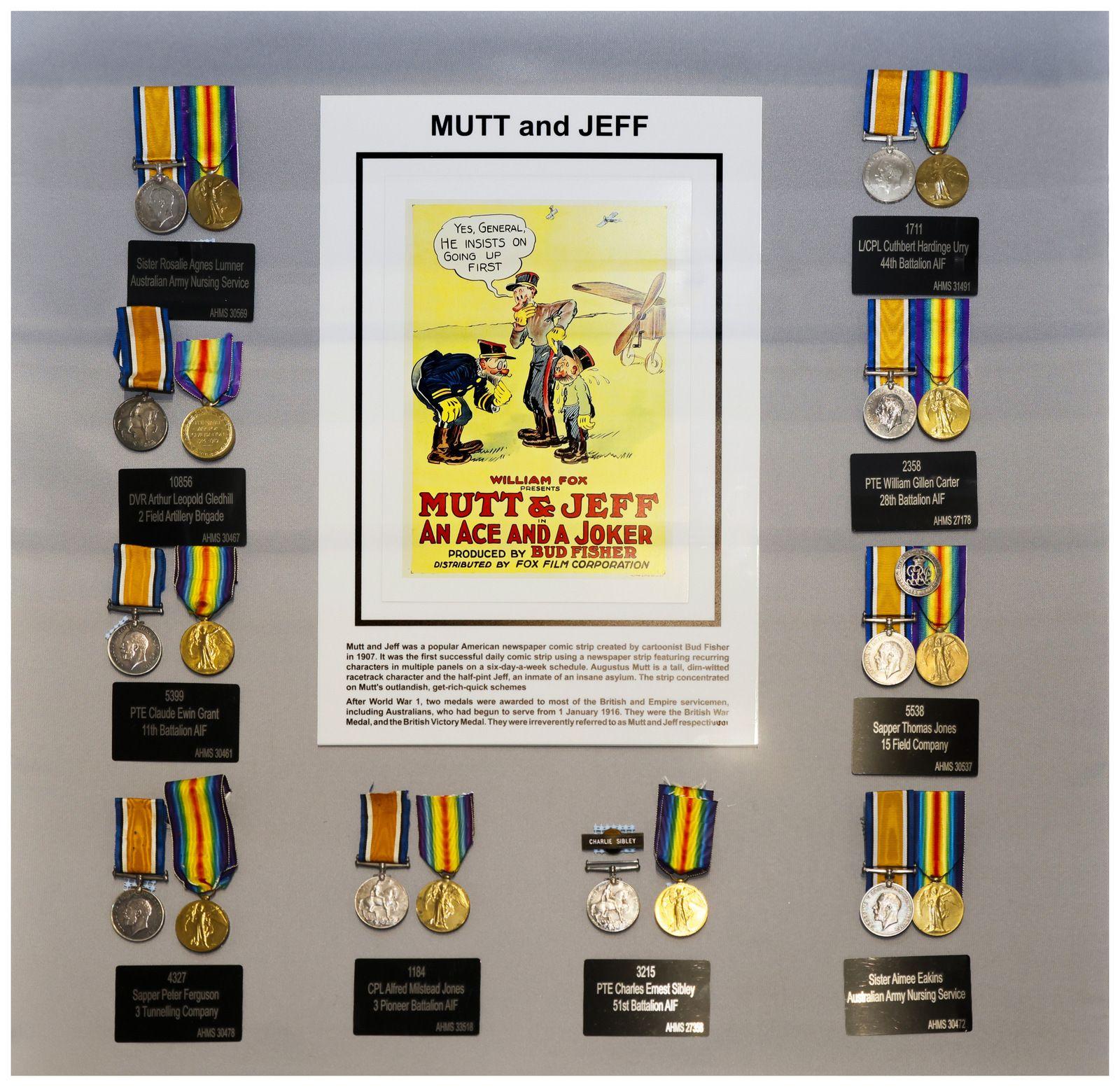
Scan this QR code to open this page on your phone ->

